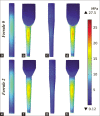Stress distribution of esthetic posts in the restored maxillary central incisor: Three-dimensional finite-element analysis
- PMID: 34084297
- PMCID: PMC8122688
Stress distribution of esthetic posts in the restored maxillary central incisor: Three-dimensional finite-element analysis
Abstract
Background: Glass fiber posts, along with their esthetic properties, may have a better stress distribution than cast posts, Therefore, the aim of the present study was to investigate the effect of glass fiber, casting, titanium, and zirconia posts on stress distribution in maxillary central tooth treated with different amounts of ferrule using finite-element analysis.
Materials and methods: In this experimental study, three-dimensional models of maxillary central incisors that have undergone root canal treatment were designed. Then, the models were divided into four groups according to the type of post (Ni-Cr casting, glass fiber, titanium, and zirconia) used. Zirconia monolithic crowns were used in all the four groups. Ferrule heights were repeated at 0 and 2 mm in all models. Models were entered into COMSOL Metaphysics software. Then, the force of 100 N with the angle of 135° on the palatal surface was applied to the longitudinal axis of the tooth, and the stress distribution in the models was investigated.
Results: Maximum stress was observed in the middle third of posts. Stress distribution in glass fiber post was better than zirconia and casting posts. Stress accumulation in models with zirconia, titanium, and casting posts was also found in the site between the middle third and coronal third, whereas in models with glass fiber post, stress accumulation was found between the crown and the cemento-enamel junction. In models without ferrule, stress accumulation was observed in one-third of the coronal, especially in glass fiber posts.
Conclusion: The post material and ferrule height affected stress concentration. The stress in the cervical area of the dentin was more for glass fiber post when compared to other posts. The use of glass fiber post in teeth with no ferrule results in lower stress along the post, but greater stress in the simulated tooth region.
Keywords: Ceramics; crowns; dental dowel; finite-element analyses; zirconium oxide.
Copyright: © 2021 Dental Research Journal.
Conflict of interest statement
The authors of this manuscript declare that they have no conflicts of interest, real or perceived, financial or non-financial in this article.
Figures



References
-
- Veríssimo C, Simamoto Júnior PC, Soares CJ, Noritomi PY, Santos-Filho PC. Effect of the crown, post, and remaining coronal dentin on the biomechanical behavior of endodontically treated maxillary central incisors. J Prosthet Dent. 2014;111:234–46. - PubMed
-
- Al-Omiri MK, Mahmoud AA, Rayyan MR, Abu-Hammad O. Fracture resistance of teeth restored with post-retained restorations: An overview. J Endod. 2010;36:1439–49. - PubMed
LinkOut - more resources
Full Text Sources
Miscellaneous
